Sepsis & Septic Shock – Symptoms, Pathophysiology, Diagnosis, Treatment
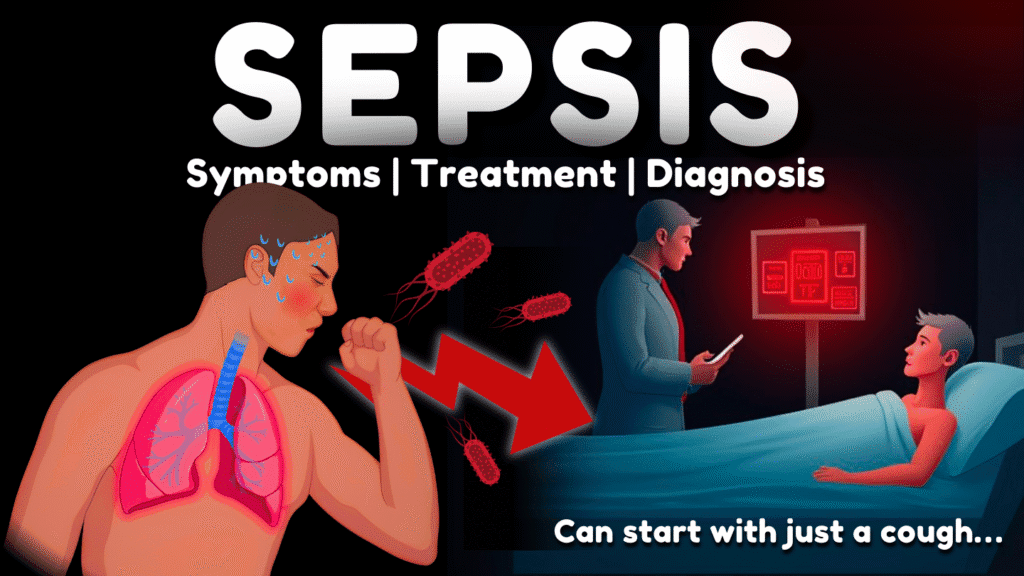
Sepsis & Septic Shock – Symptoms, Pathophysiology, Diagnosis, Treatment Official Links Instagram Youtube Jki-discord Notes & Illustrations Quizzes Summary & Transcript 📢 Currently, there is no PDF for this video.If you’re interested in having one, feel free to send an inquiry, and I may create it in the future. BUT! There’s a quiz available in the next tab. 12345678910 SEPSIS – QUIZ Test your understanding with 10 random multiple-choice questions from the question bank. You're in the preview mode. Note: All elements work correctly on the front end. 1 / 10 Which lab test supports a diagnosis of tissue hypoxia in sepsis? A) Hematocrit B) Lactate C) BUN D) CRP Elevated lactate is a marker of tissue hypoperfusion and anaerobic metabolism. 2 / 10 What happens during disseminated intravascular coagulation (DIC) in sepsis? A) Only bleeding increases B) Fibrinogen levels rise C) Only platelets decrease D) Clotting and bleeding simultaneously Widespread clotting and bleeding occurs due to impaired coagulation. 3 / 10 What role do cytokines play in sepsis? A) Boost clotting only B) Stimulate oxygen delivery C) Increase red blood cells D) Drive systemic inflammation They mediate inflammation, contributing to vasodilation, fever, and tissue damage. 4 / 10 What does low urine output in a septic patient suggest? A) Liver failure B) Dehydration from exercise C) Impaired kidney function D) Electrolyte loss It may indicate kidney hypoperfusion or acute kidney injury. 5 / 10 What is the first step before starting antibiotics in sepsis treatment? A) CT scan B) Lumbar puncture C) Nasal swab D) Blood cultures Blood cultures should be drawn before antibiotics to guide therapy. 6 / 10 Which of the following is a parasitic cause of sepsis? A) Candida albicans B) Staphylococcus aureus C) Plasmodium falciparum D) Influenza A Malaria (Plasmodium spp.) is a parasitic infection that can lead to sepsis. 7 / 10 Which score uses respiratory rate, blood pressure, and mental status to identify sepsis risk? A) CURB-65 B) qSOFA C) SOFA D) GCS The qSOFA score is a quick bedside tool used outside the ICU. 8 / 10 Which of the following is an early sign of organ dysfunction in sepsis? A) Confusion B) Hiccups C) Jaundice D) Rash Altered mental status often appears early and is part of qSOFA. 9 / 10 What does an elevated lactate level indicate in sepsis? A) High blood sugar B) Kidney failure C) Tissue hypoxia D) Normal metabolism Lactate >2 mmol/L indicates tissue hypoperfusion and cellular hypoxia. 10 / 10 What is the initial fluid resuscitation dose for sepsis? A) 10 mL/kg B) 1 L over 6 hours C) 100 mL/hr D) 30 mL/kg The recommended dose is 30 mL/kg IV fluids within the first hour. Your score is The average score is 0% Description Sepsis Overview:Sepsis is a life-threatening condition where the body’s immune system reacts excessively to an infection, causing tissue and organ damageIn 2017, there were 48.9 million cases globally and 11 million deaths.Sepsis affects anyone but is more common in the elderly, young, pregnant women, or those with chronic health conditions. Definition:Sepsis occurs when an infection triggers a chain reaction in the body Pathophysiology of Sepsis:1.Infection triggers immune response: The immune system overreacts to infections (bacterial, viral, fungal, or parasitic)2-Release of cytokines: Cells release IL-1, IL-6, TNF-α, and other mediators, causing inflammation.3.Vasodilation and permeability: Blood vessels dilate and leak, leading to hypotension4-Decreased cardiac output: Blood volume drops, reducing oxygen delivery to organs5.Tissue hypoxia and acidosis: Lack of oxygen leads to lactic acid build-up.6.Coagulation: Impaired blood clotting results in DIC.7-Multi-organ dysfunction: Key organs (heart, lungs, kidneys) are affected.8-Septic shock: Persistent low blood pressure without treatment can lead to septic shock. Causes of Sepsis:-Bacterial infections: Staphylococcus aureus, Escherichia coli, and Pseudomonas aeruginosa are common.-Viral infections: Influenza and COVID-19.-Fungal infections: Candida and Aspergillus.-Parasitic infections: Malaria (Plasmodium).-Infection sources: Pneumonia, urinary tract infections, abdominal infections, and skin infections.-Healthcare-associated infections: Infections from catheters, ventilators, or surgery.-Weakened immunity: People with compromised immune systems (chemotherapy, organ transplants) are more vulnerable. Clinical Features (TIME mnemonic):T – Temperature: High fever or low temperatureI – Infection signs: Symptoms vary (e.g., cough, shortness of breath, abdominal pain)M – Mental status: Confusion or difficulty wakingE – Extremely ill: Severe discomfort, pain, and shortness of breath Clinical Criteria for Diagnosing Sepsis:1,Infection suspected (bacterial, viral, fungal, or parasitic)2.qSOFA score:Systolic BP ≤ 100 mmHgRespiratory rate ≥ 22 breaths/minAltered mental statusqSOFA score ≥ 2 suggests higher risk3.NEWS score: NEWS ≥ 5 predicts sepsis risk based on RR, BP, and oxygen levels. Treatment for Sepsis:Blood cultures: Obtain before starting antibiotics.Lactate levels: Elevated lactate (≥ 2 mmol/L) indicates tissue hypoxia.Urine output: Monitor for over 0.5 mL/kg/h to assess kidney function.IV fluids: Start 30 mL/kg within the first hour to treat hypotension.Oxygen therapy: Maintain oxygen saturation ≥ 94% (unless chronic respiratory issues are present).Antibiotics: Administer broad-spectrum antibiotics within the first hour.Vasopressors: If fluids fail to restore BP, use vasopressors (e.g., norepinephrine) to maintain a MAP ≥ 65 mmHg.Monitoring: Track blood pressure, lactate, and urine output to ensure effective treatment. Clinical Scenario Example:Assessment: Patient with low BP (88 mmHg), rapid breathing, and confusion.Treatment: Start IV fluids, monitor BP, administer vasopressors if needed, give antibiotics immediately. Transcript Introduction0:00Sepsis is a serious condition that happens when the body’s immune system has an extreme response0:05to an infection, and this extreme immune response causes damage to its own tissue and organs.0:11A study done in 2017 showed that there were 48.9 million cases worldwide, and 11 million0:19sepsis-related deaths in the same year. It’s a very deadly condition and it’s crucial to be able0:25to recognize it early, and know what to do. Sepsis can affect anyone, but people who0:30are older, very young, pregnant or have other health problems are at higher risk.0:34So, in this video, we’re going to answer the question what is sepsis?Content0:38And we’re going to do that by going through the definition. Then go through the pathophysiology0:43for Sepsis, basically what happens within the body. Then we’re going to0:47talk a little bit about the causes. After that we’ll briefly go through0:51what the symptoms of Sepsis are using
What Are Joints? Classification, Types & Clinical Anatomy Explained
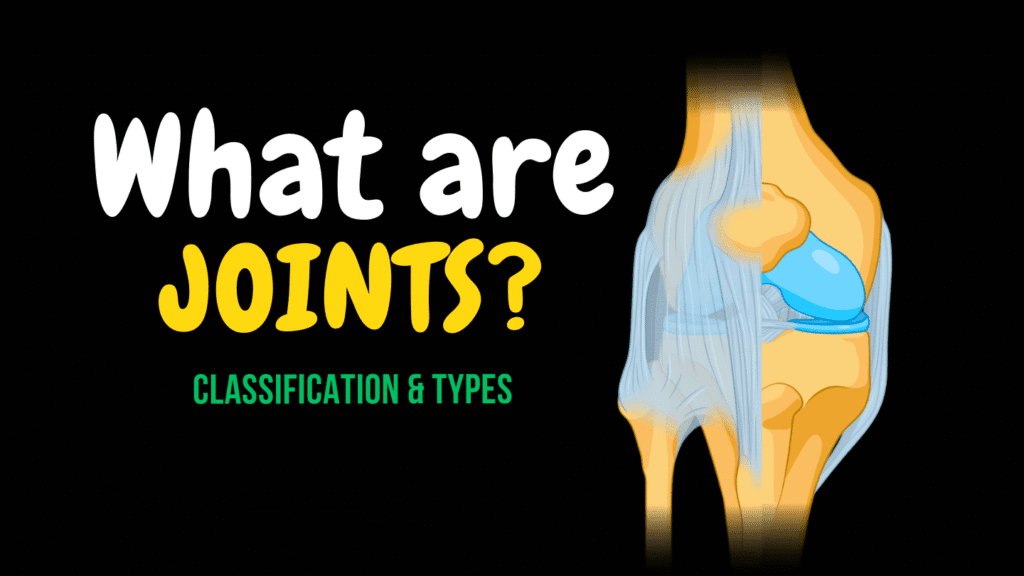
What Are Joints? Classification, Types & Clinical Anatomy Explained Official Links Instagram Youtube Jki-discord Notes & Illustrations Quizzes Summary & Transcript Notes ☆ Members Only Go to PDF Notes Illustrations ☆ Members Only Go to Illustrations 12345678910 Joints Overview – QUIZ Test your understanding with 10 random multiple-choice questions from the question bank. You're in the preview mode. Note: All elements work correctly on the front end. 1 / 10 Which ligament connects the distal tibia and fibula? A) Posterior tibiofibular ligament B) Cruciate ligament C) Anterior talofibular ligament D) Collateral ligament The posterior tibiofibular ligament is part of the syndesmosis joint. 2 / 10 What joint allows childbirth-related pelvic expansion? A) Hip joint B) Sacroiliac joint C) Pubic symphysis D) Intervertebral joint Hormonal changes increase flexibility at the pubic symphysis. 3 / 10 Which synovial joint type allows flexion, extension, abduction, adduction, and rotation? A) Pivot B) Hinge C) Saddle D) Ball-and-socket Ball-and-socket joints allow movement in all three planes. 4 / 10 The glenoid labrum is found in which joint? A) Knee joint B) Elbow joint C) Hip joint D) Shoulder joint The glenoid labrum deepens the socket of the shoulder joint. 5 / 10 The term “arthrology” refers to: A) Joint dislocations B) The study of joints C) Inflammation of joints D) Surgical repair of joints Arthrology is the study of joints. 6 / 10 What is the function of the menisci in the knee joint? A) Lubricate the joint B) Deepen the socket C) Allow rotation D) Absorb shock Menisci are fibrocartilaginous pads that absorb shock in weight-bearing joints. 7 / 10 Which joint type has flat articular surfaces and allows gliding? A) Ball-and-socket B) Plane C) Pivot D) Saddle Plane joints allow gliding movements. 8 / 10 Which structure connects bone to bone in a joint? A) Tendons B) Labrum C) Menisci D) Ligaments Ligaments stabilize joints by connecting bones. 9 / 10 The carpometacarpal joint of the thumb is an example of: A) Ellipsoid joint B) Hinge joint C) Saddle joint D) Plane joint This joint is a saddle joint enabling thumb opposition. 10 / 10 Which joint type consists of bones connected by hyaline cartilage? A) Symphysis B) Synchondrosis C) Gomphosis D) Syndesmosis Synchondroses are primary cartilaginous joints made of hyaline cartilage. Your score is The average score is 0% Description This video is about joint classification, structure, function, and clinical relevance. Topics covered in this video: • What are joints?• Joint classification based on structure and function• Types of joints in the human body• Examples of fibrous, cartilaginous, and synovial joints• Subtypes of each joint category with real anatomical examples• Clinical relevance of joints (e.g., high ankle sprains, TMJ, arthritis)• Supporting structures: ligaments, bursae, menisci, labrum, fat pads• Functional mobility: synarthrosis, amphiarthrosis, diarthrosis• Synovial joint types: – Ball-and-socket joint (shoulder, hip) – Ellipsoid joint (wrist) – Saddle joint (thumb) – Hinge joint (elbow, knee, fingers) – Pivot joint (atlantoaxial, radioulnar) – Plane joint (acromioclavicular, vertebral facet joints) Joint classification explained:• Fibrous joints – sutures (suturae), syndesmoses, gomphoses• Cartilaginous joints – synchondroses (hyaline cartilage), symphyses (fibrocartilage)• Synovial joints – contain a joint cavity filled with synovial fluid – include articular cartilage, synovial membrane, joint capsule – supported by ligaments, tendons, labrum, bursae, menisci Clinical anatomy references include:• Atlantoaxial joint (articulatio atlantoaxialis mediana)• Glenohumeral joint (articulatio humeri)• Temporomandibular joint (articulatio temporomandibularis)• Proximal radioulnar joint (articulatio radioulnaris proximalis)• Pubic symphysis (symphysis pubica)• Costochondral joints (junctiones costochondrales)• Intervertebral discs (disci intervertebrales)• Distal tibiofibular syndesmosis (syndesmosis tibiofibularis distalis) Whether you’re a medical student or revising anatomy for clinical practice, this video breaks down complex arthrology in a visual, memorable way. Transcript 0:00Joints. They come in many forms, but at their core, joints exist to link bones0:05together and allow movement. Some let you rotate your arm in every direction,0:10some move just a little bit, and some, like the joints in your skull, don’t move at all.0:16You don’t really think about them, until something goes wrong. When joints wear down,0:21become inflamed, or stop working properly, even the simplest movements can become difficult.0:27So, why are some joints flexible while others are completely rigid? What makes0:32one joint allow movement while another barely moves at all? And how do we actually classify0:38all the different joints in the body? In this video, we’ll start by answering0:43the fundamental question – what are joints? Then, we’ll go through all the joints in the body and0:49classify them based on their structure and function. As we go through them,0:54we’ll also highlight their clinical relevance, understanding how joint problems develop and0:58what makes them vulnerable to damage. Hey everyone, my name is Taim. I’m a1:02medical doctor, and I make animated medical lectures to make different topics in medicine1:06visually easier to understand. If you’d like a PDF version or a quiz of this presentation, you can1:11find it on my website, along with organized video lectures to help with your studies.1:15Alright, let’s get started! So what are joints?What are Joints?1:19Just, in simple terms, The point at which two bones lay adjacent to each1:24other (with or without the ability to move) is called a joint. Let’s visualize this.1:30Here we see a bone. Here is another bone. The point at which they lay adjacent to1:35each other is a joint. Here are two bones, between them, a joint. Here are two bones,1:41between them a joint. And even, I’ll surprise you now. Even between your skull bones, is a joint.1:48So joints come in different shape, and they are structurally and functionally different.1:54For example. The shoulder joint is1:56called the glenohumeral joint. Structurally, we call this a Synovial joint, Functionally,2:02it’s a Diarthrosis, since it’s a freely movable joint. And we subclassify it as a ball-and-socket2:09joint, which provides free rotational movement. Between the articular surfaces of vertebrae,2:15we got the facet joint, or zygapophyseal joints. They are synovial joints,2:20functionally movable so diarthrosis as well, but subclassified as plane joint,2:26allowing only gliding movements. Okay, let’s take another example, in the skull we got2:32sutures. Or lambdoid suture is what we’re pointing at specifically now. Structurally,2:37it’s a strong fibrous joint. And functionally, a Synarthrosis, meaning a joint that does
Joints Overview
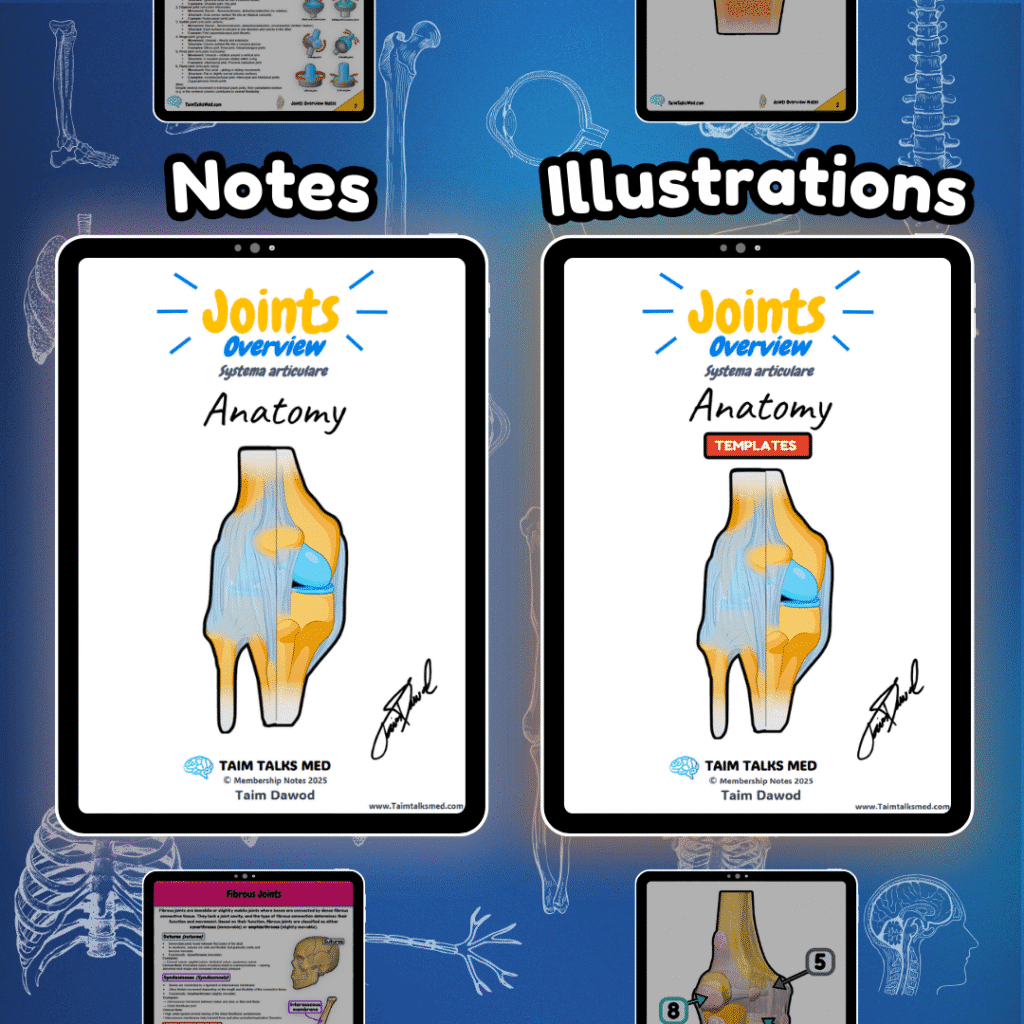
Joints Overview Skeletal System Skeletal System Notes 📅 Last Updated: 01.04.2025 🔄 Version: 1.0 This PDF covers the classification of the joint system, including both structural (fibrous, cartilaginous, synovial) and functional (synarthrosis, amphiarthrosis, diarthrosis) types. This section gives you a solid foundation before learning about the individual joints. Become a Member Buy this PDF Go To Notes (Preview) Go to Illustrations (Preview) Watch The Lecture Go To Notes Go to Illustrations Watch The Lecture Need it offline? Open PDF → Click the three-dot menu → Download PDF. 📖 Sources: Gray’s Anatomy: The Anatomical Basis of Clinical Practice (42nd ed.) Tubbs RS, Shoja MM, Loukas M. (2016). Kozlowski, T. Memorix Anatomy (2nd ed.)
Skull Bones & Joints
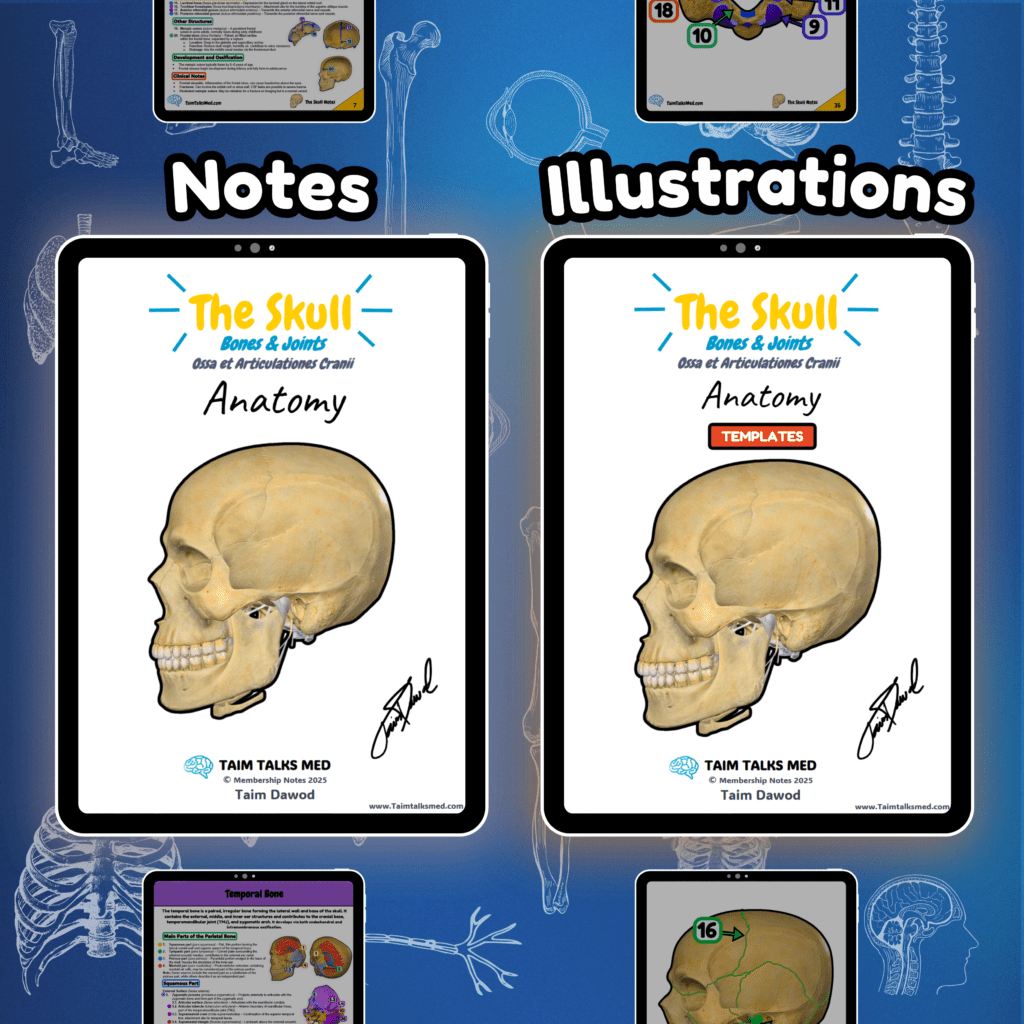
Skull Bones & Joints Skeletal System Skeletal System Notes 📅 Last Updated: 01.04.2025 🔄 Version: 1.0 This PDF is about the bones and joints of the skull. It explains all the major bones that form the braincase and the face, along with how they connect through sutures, cartilage joints, and the movable jaw joint (TMJ). You’ll also find pages about how the skull develops, the soft spots in newborns (fontanelles), and how the bones change as we grow. Each bone is shown with clear names, surfaces, and features, and there are notes on how these structures relate to common injuries or conditions like fractures or TMJ problems. The content is made for medical students and doctors who want clear and detailed skull anatomy. Become a Member Go To Notes (Preview) Go to Illustrations (Preview) Watch The Lecture Go To Notes Go to Illustrations Watch The Lecture Need it offline? Open PDF → Click the three-dot menu → Download PDF. 📖 Sources: Gray’s Anatomy: The Anatomical Basis of Clinical Practice (42nd ed.) Tubbs RS, Shoja MM, Loukas M. (2016). Bergman’s Encyclopedia of Human Anatomic Variation. White TD, Folkens PA. (2005). The Human Bone Manual. Kozlowski, T. Memorix Anatomy (2nd ed.)
Skull Bones: Viscerocranium (Facial Skeleton + Hyoid Bone)
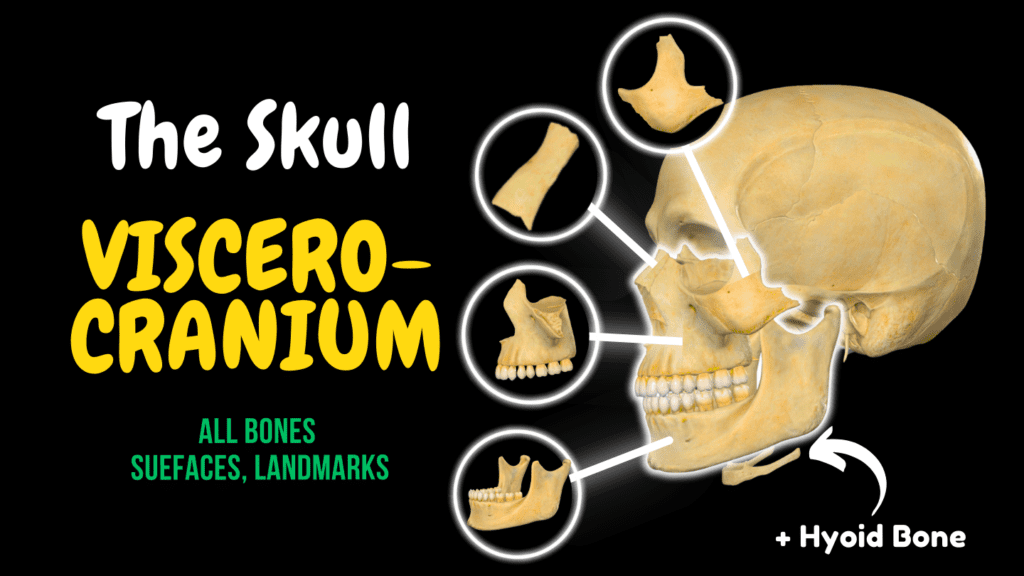
Skull Bones: Viscerocranium (Facial Skeleton + Hyoid Bone) Official Links Instagram Youtube Jki-discord Notes & Illustrations Quizzes Summary & Transcript Notes ☆ Members Only Go to PDF Notes Illustrations ☆ Members Only Go to Illustrations 12345678910 Viscerocranium – QUIZ Test your understanding with 10 random multiple-choice questions from the question bank. You're in the preview mode. Note: All elements work correctly on the front end. 1 / 10 Which facial bones articulate medially at the internasal suture? A) Nasal bones B) Lacrimal bones C) Maxillae D) Zygomatic bones The two nasal bones meet medially at this suture. 2 / 10 What muscle attaches to the nasal bone? A) Levator labii superioris B) Procerus and nasalis C) Orbicularis oculi D) Buccinator The procerus and nasalis attach to the nasal bones and control facial expressions. 3 / 10 What structure articulates with the vomer to form the nasal septum? A) Ethmoidal crest B) Inferior nasal concha C) Conchal crest D) Nasal crest The nasal crest of the maxilla articulates with the vomer. 4 / 10 The ethmoidal crest of the palatine bone is the attachment site for: A) Vomer B) Middle nasal concha C) Maxilla D) Inferior nasal concha The ethmoidal crest articulates with the middle nasal concha. 5 / 10 What passes through the nasal foramen of the nasal bone? A) Emissary veins B) Zygomatic nerve C) Ethmoidal artery D) Greater palatine vessels Small emissary veins pass through the nasal foramen. 6 / 10 What structure forms the prominence of the cheek? A) Zygomatic bone B) Frontal process C) Maxilla D) Lacrimal bone The zygomatic bone forms the lateral cheek contour. 7 / 10 What foramen transmits nerves to the cheek and temple? A) Infraorbital foramen B) Supraorbital foramen C) Mandibular foramen D) Zygomaticoorbital foramina The zygomaticoorbital foramina carry zygomatic nerve branches. 8 / 10 What bone forms the posterior-inferior part of the nasal septum? A) Vomer B) Maxilla C) Ethmoid bone D) Inferior nasal concha The vomer contributes to the posterior-inferior portion of the septum. 9 / 10 The sphenopalatine foramen transmits which of the following? A) Sphenopalatine artery and nasopalatine nerve B) Greater palatine vessels C) Zygomatic nerve D) Infraorbital nerve The sphenopalatine artery and nasopalatine nerve pass through it into the nasal cavity. 10 / 10 Which bone forms the lower jaw? A) Mandible B) Palatine C) Maxilla D) Zygomatic The mandible is the only movable bone of the facial skeleton. Your score is The average score is 0% Description This video is about the viscerocranium.Bones of the skull:• Neurocranium – surrounds the brain• Viscerocranium – forms the facial skeleton Bones included in the viscerocranium:• Maxilla (maxilla) – paired• Zygomatic bone (os zygomaticum) – paired• Palatine bone (os palatinum) – paired• Nasal bone (os nasale) – paired• Lacrimal bone (os lacrimale) – paired• Inferior nasal concha (concha nasalis inferior) – paired• Vomer (vomer) – unpaired• Mandible (mandibula) – unpaired• Hyoid bone (os hyoideum) – unpaired Maxilla:• Body (corpus maxillae)• Maxillary sinus (sinus maxillaris)• Frontal process• Zygomatic process (processus zygomaticus maxillae)• Alveolar process (processus alveolaris)• Palatine process (processus palatinus)• Infraorbital margin• Infraorbital groove (sulcus infraorbitalis)• Infraorbital canal (canalis infraorbitalis)• Infraorbital foramen (foramen infraorbitale)• Canine fossa (fossa canina)• Canine eminence (eminentia canina)• Nasal notch (incisura nasalis)• Maxillary tuberosity (tuber maxillae)• Alveolar foramina (foramina alveolaria)• Nasal crest (crista nasalis)• Conchal crest (crista conchalis)• Ethmoidal crest (crista ethmoidalis)• Lacrimal notch (incisura lacrimalis)• Lacrimal groove (sulcus lacrimalis)• Greater palatine groove (sulcus palatinus major)• Dental alveoli (alveoli dentales maxillae)• Interalveolar septa (septa interalveolaria)• Interradicular septa (septa interradicularia)• Palatine grooves (sulci palatini)• Incisive canal (canalis incisivus) Zygomatic bone:• Frontal process (processus frontalis ossis zygomatici)• Temporal process (processus temporalis ossis zygomatici)• Orbital surface (facies orbitalis)• Zygomaticofacial foramen (foramen zygomaticofaciale)• Zygomaticotemporal foramen (foramen zygomaticotemporale)• Zygomaticoorbital foramina (foramina zygomaticoorbitalia)• Zygomatic arch (arcus zygomaticus) Palatine bone:• Horizontal plate (lamina horizontalis)• Perpendicular plate (lamina perpendicularis)• Pyramidal process (processus pyramidalis)• Sphenoidal process (processus sphenoidalis)• Orbital process (processus orbitalis)• Nasal surface (facies nasalis)• Palatine surface (facies palatina)• Maxillary surface (facies maxillaris)• Nasal crest (crista nasalis)• Conchal crest (crista conchalis)• Ethmoidal crest (crista ethmoidalis)• Sphenopalatine notch (incisura sphenopalatina)• Greater palatine groove (sulcus palatinus major)• Greater palatine canal (canalis palatinus major)• Lesser palatine foramina (foramina palatina minora)• Greater palatine foramen (foramen palatinum majus) Lacrimal bone:• Lacrimal groove (sulcus lacrimalis)• Lacrimal fossa (fossa sacci lacrimalis) Nasal bone:• Internasal suture (sutura internasalis)• Frontonasal suture (sutura frontonasalis)• Nasal foramen (foramen nasale)• Ethmoidal groove (sulcus ethmoidalis) Inferior nasal concha (concha nasalis inferior):• Separate bone, distinct from ethmoid conchae• Increases nasal surface area• Aids in humidification and filtration of air Vomer:• Posterior part of nasal septum• Articulates with:– Perpendicular plate of ethmoid (lamina perpendicularis ossis ethmoidalis)– Maxilla– Palatine bone– Sphenoid bone Mandible:• Body (corpus mandibulae)• Ramus (ramus mandibulae)• Angle (angulus mandibulae)• Coronoid process (processus coronoideus)• Condylar process (processus condylaris)• Head of mandible (caput mandibulae)• Neck of mandible (collum mandibulae)• Mandibular notch (incisura mandibulae)• Fovea for lateral pterygoid (fovea pterygoidea)• Mental foramen (foramen mentale)• Alveolar part (pars alveolaris mandibulae)• Mental protuberance (protuberantia mentalis)• Mental tubercles (tubercula mentalia)• Oblique line• Mandibular symphysis (symphysis mandibulae)• Superior mental spines (spinae mentales superiores)• Inferior mental spines (spinae mentales inferiores)• Mylohyoid line• Sublingual fossa (fovea sublingualis)• Submandibular fossa (fovea submandibularis)• Mylohyoid groove (sulcus mylohyoideus)• Mandibular foramen (foramen mandibulae)• Mandibular canal (canalis mandibulae)• Digastric fossa (fossa digastrica) Hyoid bone (os hyoideum):• Body (corpus ossis hyoidei)• Greater horns (cornua majora)• Lesser horns (cornua minora) Sources:Standring S. (2020). Gray’s Anatomy, 42nd ed.Tubbs RS, Shoja MM, Loukas M. (2016). Bergman’s Encyclopedia of Human Anatomic Variation.White TD, Folkens PA. (2005). The Human Bone Manual. Programs: Complete Anatomy, Biorender, Powerpoint Transcript Introduction0:00In the previous video, we covered the bones of the neurocranium, the part of the skull0:04that protects the brain. But what about the bones that shape our face, hold our teeth,0:08and form the structure of our nasal cavity and orbits? That’s where the viscerocranium comes in.0:14While the neurocranium safeguards the brain, the viscerocranium is responsible for everything we0:20recognize in a person’s face – from the curve of the cheekbones to the structure of the jaw.0:25In this video, we’ll go
Skull Bones: Neurocranium (Frontal, Parietal, Temporal, Occipital, Sphenoid, Ethmoid)
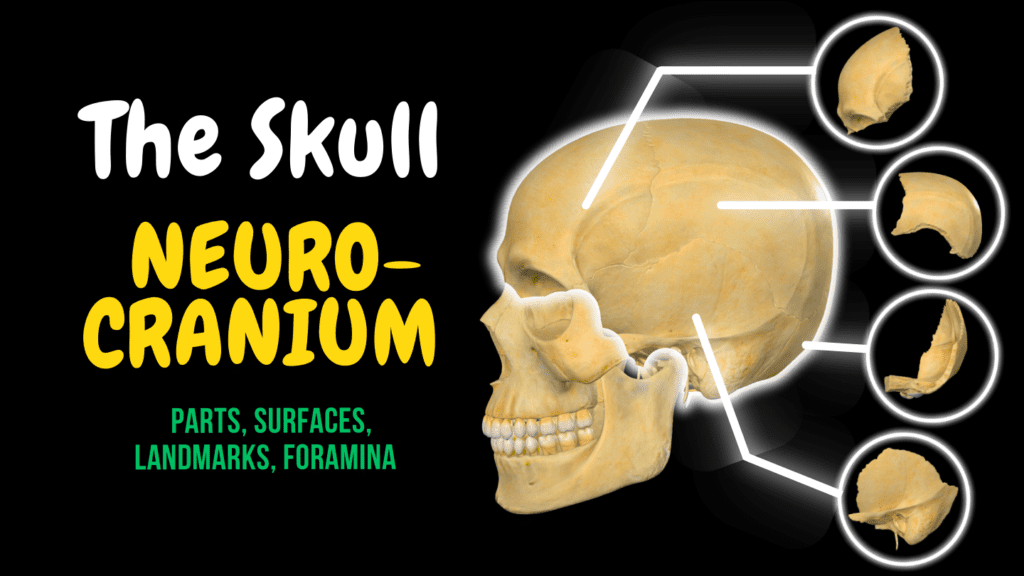
Skull Bones: Neurocranium (Frontal, Parietal, Temporal, Occipital, Sphenoid, Ethmoid) Official Links Instagram Youtube Jki-discord Notes & Illustrations Quizzes Summary & Transcript Notes ☆ Members Only Go to PDF Notes Illustrations ☆ Members Only Go to Illustrations 12345678910 Neurocranium – QUIZ Test your understanding with 10 random multiple-choice questions from the question bank. You're in the preview mode. Note: All elements work correctly on the front end. 1 / 10 What are the main parts of the occipital bone? A) Squamous, basilar, and two lateral parts B) Temporal, sphenoidal, and nuchal C) Body, lesser wing, greater wing, and pterygoid D) Squamous, mastoid, petrous, and occipital condyles The occipital bone has four parts: one squamous, one basilar, and two lateral parts. 2 / 10 Which of the following foramina transmit the mandibular nerve? A) Foramen ovale B) Foramen spinosum C) Jugular foramen D) Foramen rotundum The mandibular nerve passes through the foramen ovale. 3 / 10 Which two structures are associated with the superior and inferior temporal lines? A) Parotid gland and stylomastoid artery B) Epicranial aponeurosis and mastoid notch C) Trapezius and sternocleidomastoid D) Temporal fascia and temporalis muscle The superior line marks the fascia attachment, while the inferior is origin for the temporalis muscle. 4 / 10 What passes through the parietal foramen? A) Parietal emissary vein B) Middle meningeal artery C) Superior temporal vein D) Supraorbital nerve The parietal emissary vein passes through the parietal foramen, connecting extracranial veins to intracranial sinuses. 5 / 10 What are the contents of the foramen magnum? A) Optic chiasm and oculomotor nerve B) Facial nerve and labyrinthine artery C) Medulla, arteries, nerves, and spinal vein D) Jugular vein and glossopharyngeal nerve It contains the medulla, spinal arteries, vertebral arteries, accessory nerve root and spinal vein. 6 / 10 What nerves pass through the supraorbital notch and frontal notch? A) Infraorbital and zygomatic nerves B) Oculomotor and lacrimal nerves C) Lateral and medial supraorbital nerve branches D) Optic and trochlear nerves These notches transmit the lateral and medial branches of the supra-orbital nerve. 7 / 10 What structure is found on the internal surface of the parietal bone and houses venous blood from the brain? A) Parietal eminence B) Sagittal suture C) Groove for superior sagittal sinus D) Groove for middle meningeal artery The groove for the superior sagittal sinus contains the superior sagittal sinus, a major dural venous sinus. 8 / 10 Which part of the temporal bone contains the mastoid air cells? A) Tympanic part B) Squamous part C) Petrous part D) Mastoid process The mastoid process of the temporal bone houses mastoid air cells. 9 / 10 The anterior clinoid processes serve as attachment for which structure? A) Middle meningeal artery B) Tentorium cerebelli C) Superior oblique muscle D) Trigeminal nerve The tentorium cerebelli attaches to both anterior and posterior clinoid processes. 10 / 10 Which angle of the parietal bone lies toward the sphenoid bone? A) Sphenoid angle B) Mastoid angle C) Occipital angle D) Frontal angle The parietal bone has four angles; the sphenoid angle lies near the sphenoid bone. Your score is The average score is 0% Description This video is about the neurocranium AnatomyBones of the skull:Neurocranium: forms the protective case around the brainViscerocranium: forms the facial skeleton Neurocranium:Skullcap (calvaria):Frontal bone – os frontaleParietal bones (paired) – ossa parietaliaOccipital bone – os occipitale Cranial base (basis cranii):Temporal bones (paired) – ossa temporaliaSphenoid bone – os sphenoidaleEthmoid bone – os ethmoidale Frontal boneCoronal suture – sutura coronalisSupraorbital margin – margo supraorbitalisSupraorbital notch – incisura supraorbitalisFrontal notch – incisura frontalisZygomatic process – processus zygomaticusFrontal eminence – tuber frontaleSuperciliary arches – arcus superciliaresGlabellaFrontal crest – crista frontalisGroove for superior sagittal sinus – sulcus sinus sagittalis superiorisTemporal lines – lineae temporales (also on parietal)Lacrimal fossa – fossa glandulae lacrimalisTrochlear fovea/spine – fovea trochlearis / spina trochlearisNasal spineEthmoidal grooves (anterior/posterior) – sulci ethmoidales anterior et posteriorFrontal sinus – sinus frontalis Parietal bonesSagittal, coronal, lambdoid, squamous suturesAngles: frontal, occipital, sphenoidal, mastoid – anguli frontalis, occipitalis, sphenoidalis, mastoideusParietal eminence – tuber parietaleParietal foramen – foramen parietaleGrooves: superior sagittal sinus, sigmoid sinus, middle meningeal artery – sulci sinus sagittalis superioris, sigmoidei, arteriae meningeae mediaeTemporal lines (also on frontal) Occipital boneForamen magnumOccipital condylesHypoglossal canal – canalis nervi hypoglossiExternal/internal occipital protuberance – protuberantia occipitalis externa/internaExternal occipital crest – crista occipitalis externaNuchal lines – lineae nuchales suprema, superior et inferiorCruciform eminence – eminentia cruciformisCerebral/cerebellar fossae – fossae cerebrales et cerebellaresClivusPharyngeal tubercle – tuberculum pharyngeumSinus grooves: transverse, occipital, sigmoid, superior sagittal – sulci sinuumInferior petrosal sinus groove – sulcus sinus petrosi inferiorisJugular notch – incisura jugularis, intrajugular process – processus intrajugularisSutures: lambdoid, occipitomastoid; spheno-occipital synchondrosis Temporal boneSquamous part:Zygomatic process – processus zygomaticusMandibular fossa – fossa mandibularis, articular tubercle – tuberculum articulareSupramastoid crest – crista supramastoidea Tympanic part:External acoustic meatus – meatus acusticus externusTympanic ring – anulus tympanicusPetrotympanic fissure Petrous part:Apex – apex partis petrosaeArcuate eminence – eminentia arcuata, tegmen tympaniTrigeminal impression – impressio trigeminalisGrooves: greater/lesser petrosal nerves, superior/inferior petrosal sinusesInternal acoustic meatus – meatus acusticus internusSubarcuate fossa – fossa subarcuata, jugular notch – incisura jugularis Mastoid part:Mastoid process – processus mastoideus, mastoid notch – incisura mastoideaGroove for occipital artery – sulcus arteriae occipitalisStylomastoid foramen – foramen stylomastoideumStyloid process – processus styloideusFacial canal – canalis facialis Sphenoid boneBody – corpus ossis sphenoidalis, sella turcica with hypophyseal fossa, dorsum sellae, clinoid processes, tuberculum sellaePrechiasmatic sulcus – sulcus chiasmatis, carotid sulcus – sulcus caroticus Wings:Greater wings – alae majores: foramina rotundum, ovale, spinosumLesser wings – alae minores: optic canal – canalis opticusSuperior/inferior orbital fissures – fissurae orbitales Pterygoid processes – processus pterygoideiMedial/lateral plates – laminae medialis et lateralisPterygoid hamulus – hamulus pterygoideus, pterygoid/scaphoid fossaeSphenoidal crest – crista sphenoidalis, conchae – conchae sphenoidales, sinuses – sinus sphenoidales, rostrum Ethmoid boneCribriform plate & foramina – lamina / foramina cribrosa, crista galliPerpendicular plateEthmoidal labyrinths – labyrinthus ethmoidalis (ethmoidal cells: anterior, middle, posterior)Superior/middle nasal conchae – conchae nasalesUncinate processOrbital plate – lamina orbitalisEthmoidal foramina: anterior/posterior – foramina ethmoidalia Transcript Introduction0:00The human skull consists of 22 bones, which, in adults, are mostly connected together through0:06strong
Peritoneum
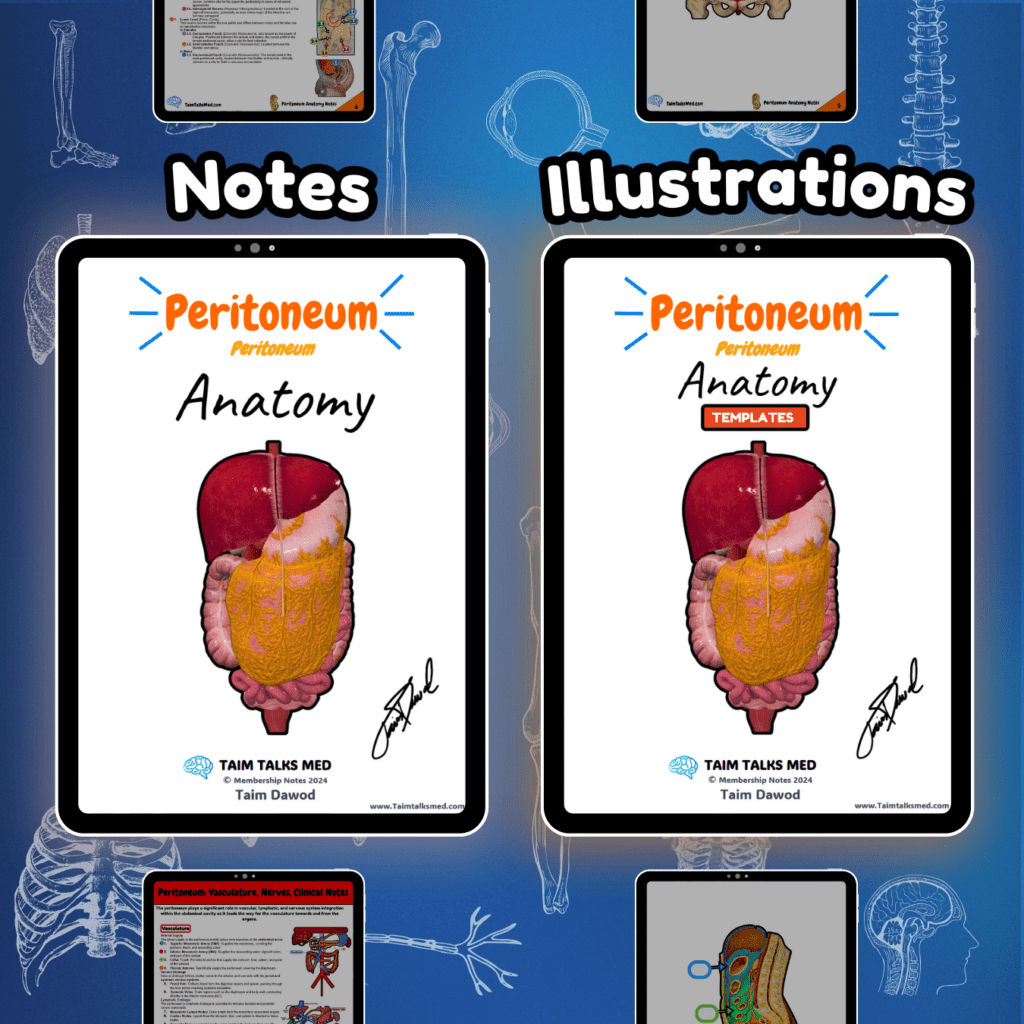
Peritoneum Digestive System Digestive System Notes 📅 Last Updated: 01.01.2025 🔄 Version: 1.0 This PDF covers the peritoneum, including its layers, compartments, and clinical relevance. The peritoneum is a serous membrane that lines the abdominal cavity, supporting and protecting organs while providing a frictionless surface for movement. It consists of parietal and visceral layers, enclosing the peritoneal cavity, and includes structures such as the omentum, mesentery, and ligaments. The peritoneal cavity is divided into supramesocolic, inframesocolic, and pelvic compartments, with clinical relevance in conditions such as ascites and peritonitis. Become a Member Buy this bundle Go To Notes (Preview) Go to Illustrations (Preview) Watch The Lecture Go To Notes Go to Illustrations Watch The Lecture Need it offline? Open PDF → Click the three-dot menu → Download PDF. 📖 Sources: Singh, I. Human Neuroanatomy (10th ed.) Kozlowski, T. Memorix Anatomy (2nd ed.) Gray’s Anatomy: The Anatomical Basis of Clinical Practice (42nd ed.) Sinnatamby, C. S. Last’s Anatomy (12th ed.)
Lower Limb Muscles

Lower Limb – Muscles and Fascia Muscular System Muscular System Notes 📅 Last Updated: 01.01.2025 🔄 Version: 1.0 In this PDF, the muscles and fascia of the lower limb are covered, detailing their function, innervation, and vasculature. It also includes clinical aspects such as compartment syndrome, piriformis syndrome, plantar fasciitis, and common athletic injuries. Become a Member Buy this bundle Go To Notes (Preview) Go to Illustrations (Preview) Watch The Lectures Go To Notes Go to Illustrations Watch The Lectures Need it offline? Open PDF → Click the three-dot menu → Download PDF. 📖 Sources: Memorix Anatomy (2nd ed.) Gray’s Anatomy: The Anatomical Basis of Clinical Practice (42nd ed.)
Pelvic Floor Muscles
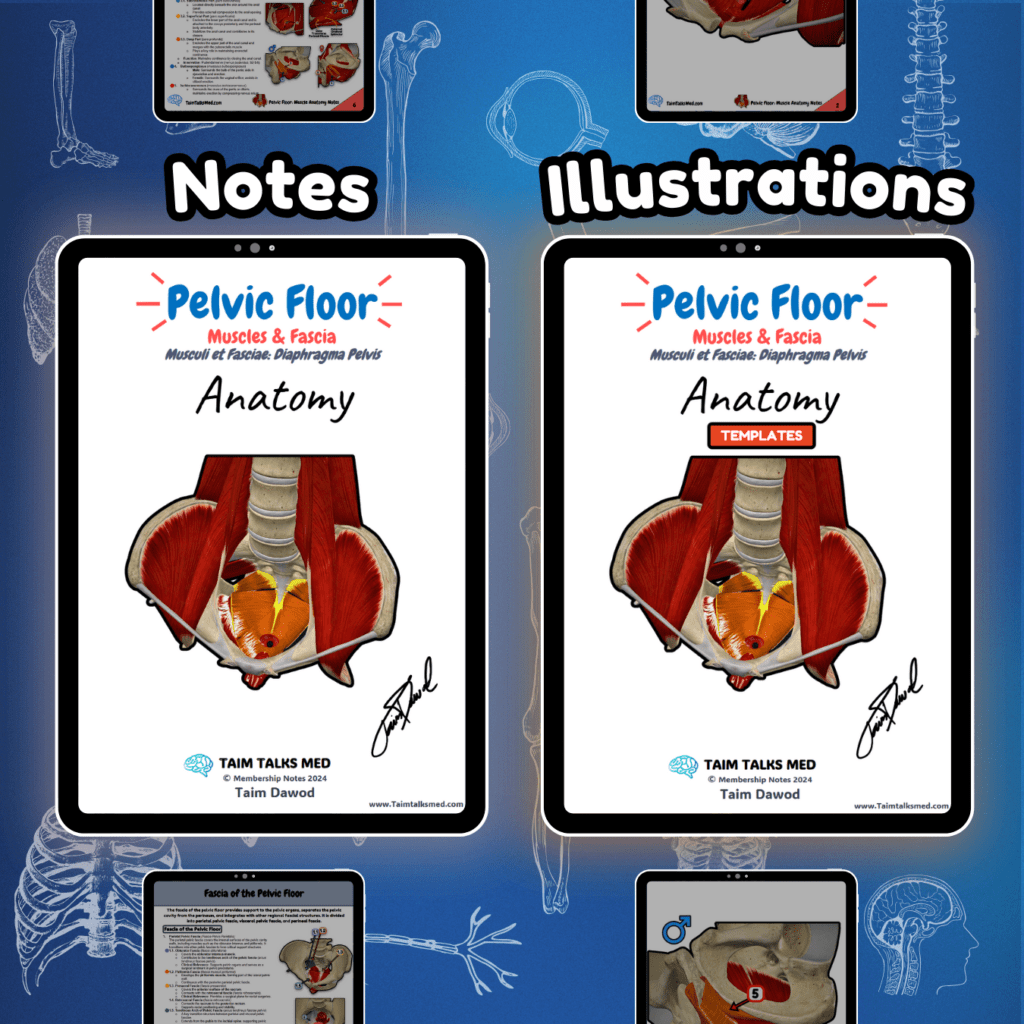
Pelvic Floor – Muscles and Fascia Muscular System Muscular System Notes 📅 Last Updated: 01.01.2025 🔄 Version: 1.0 In this PDF, the pelvic floor muscles are discussed in detail, including the levator ani, coccygeus, and perineal muscles. It covers their attachments, fascia, vascular supply, innervation, and their role in continence, organ support, and intra-abdominal pressure regulation. Clinical aspects such as pelvic organ prolapse, incontinence, and childbirth injuries are also included. Become a Member Buy this bundle Go To Notes (Preview) Go to Illustrations (Preview) No video lecture available yet Go To Notes Go to Illustrations No video lecture available yet Need it offline? Open PDF → Click the three-dot menu → Download PDF. 📖 Sources: Memorix Anatomy (2nd ed.) Gray’s Anatomy: The Anatomical Basis of Clinical Practice (42nd ed.)
Upper Limb Muscles
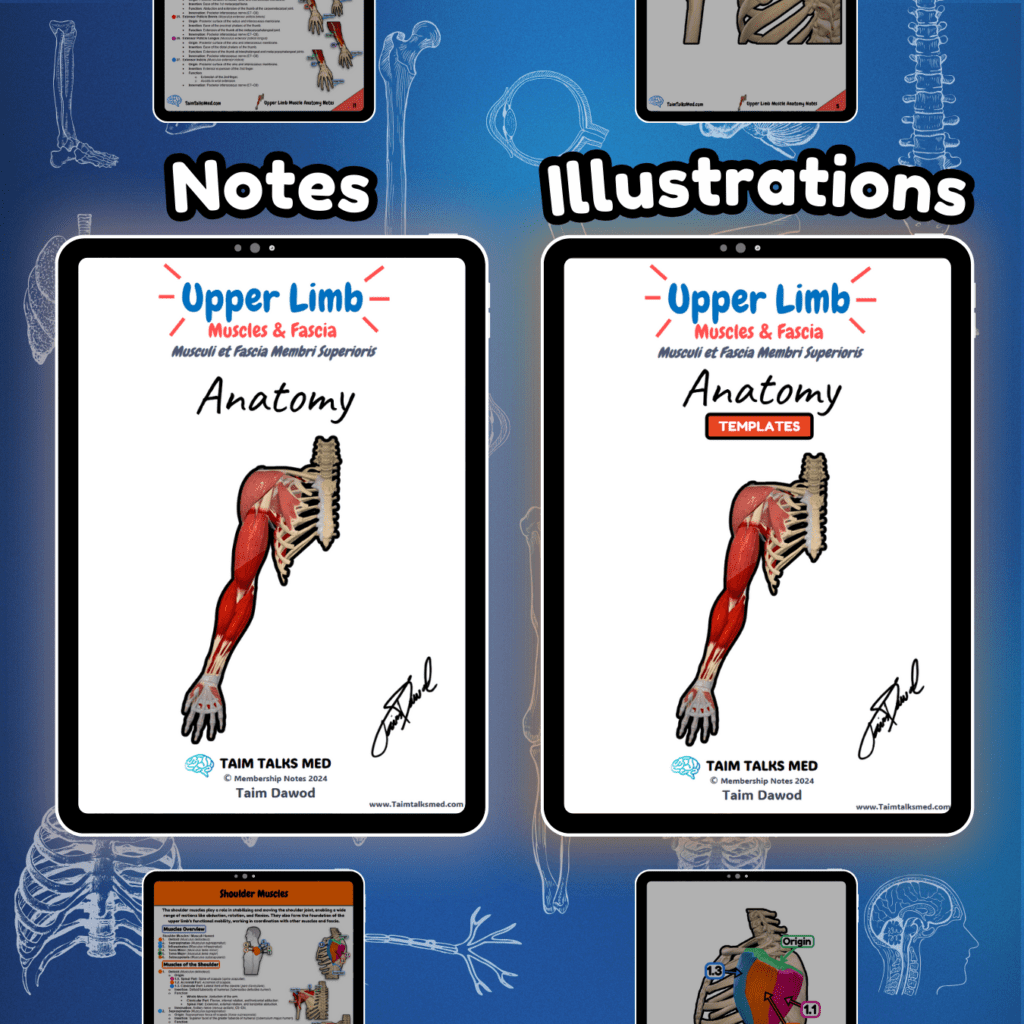
Upper Limb – Muscles and Fascia Muscular System Muscular System Notes 📅 Last Updated: 01.01.2025 🔄 Version: 1.0 In this PDF, the muscles and fascia of the upper limb are covered, including the shoulder, arm, forearm, and hand. It details muscle functions, innervation, vasculature, and clinical conditions like rotator cuff injuries, carpal tunnel syndrome, and epicondylitis. Become a Member Buy this bundle Go To Notes (Preview) Go to Illustrations (Preview) Watch The Lectures Go To Notes Go to Illustrations Watch The Lectures Need it offline? Open PDF → Click the three-dot menu → Download PDF. 📖 Sources: Memorix Anatomy (2nd ed.) Gray’s Anatomy: The Anatomical Basis of Clinical Practice (42nd ed.)
